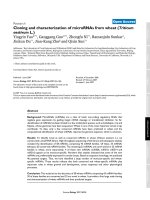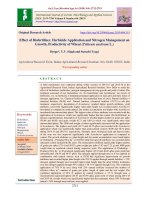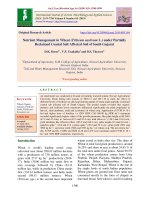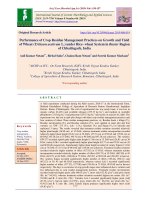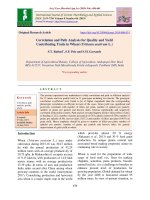Effect of fertilizers and foliar application of nutrient on wheat (Triticum aestivum L.) grain yield through conduct on farm trails at farmers fields
Bạn đang xem bản rút gọn của tài liệu. Xem và tải ngay bản đầy đủ của tài liệu tại đây (153.39 KB, 6 trang )
Int.J.Curr.Microbiol.App.Sci (2020) 9(7): 1551-1556
International Journal of Current Microbiology and Applied Sciences
ISSN: 2319-7706 Volume 9 Number 7 (2020)
Journal homepage:
Original Research Article
/>
Effect of Fertilizers and Foliar Application of Nutrient on
Wheat (Triticum aestivum L.) Grain Yield through conduct on
Farm Trails at Farmers Fields
Ratan Lal Solanki1*, Priyanka Swami1, K. C. Nagar2 and A. K. Dashora3
1
KVK, Chittorgarh, India
2
KVK, Bhilwara, India
3
RCA, Udaipur (MPUAT, Udaipur), Rajasthan 312001, India
*Corresponding author
ABSTRACT
Keywords
Conduct OFT
Wheat, Fertilizer
application,
18:18:18 NPK,
Technology
dissemination,
Yield and
Economics
Article Info
Accepted:
14 June 2020
Available Online:
10 July 2020
The field experiment on farm trial (OFT) was conducted on effect of balanced
fertilizers doses of fertilizers and foliar spray of nitrogen, phosphorus and
potassium on grain yield of Wheat during the Rabi season of the year 2013-14 in
order to develop fertilizer prescriptions for the desired yield targets treatments
viz., farmers practice, recommended fertilizers –RDF (Balanced fertilizers) and
RDF +18:18:18 NPK 1% foliar application at flowering stage. In this experiment
application of chemical balanced fertilizers -RDF +18:18:18 NPK 1% foliar spray
application increased 09.63 per cent in economic yield than the farmers practice
during the year. The net return also showed increase of Rs. 6275/- ha-1 under
chemical balanced fertilizers -RDF +18:18:18 NPK 1% foliar spray application
than farmer practices during the year. Application of 18:18:18 NPK 1% spray at
flowering recorded maximum yield (6260 kg ha-1), higher net return (6275 Rs. ha1
) with benefit cost ratio of 2.39.
Introduction
Wheat (Triticum aestivum L.) is the most
important food grain crop cultivated Rabi
season crop grown in the tropics and
subtropics despite the relatively high
temperature that occur during the growth
cycle. Heat stress is an important constraint to
wheat productivity affecting growth stages
specially anthesis and grain filling. It has
already been established that heat stress is
significant factor in reducing the yield and
quality of grains and it is a major challenge to
wheat productivity in India. The current
problem of wheat contributing in low yield is
the use of old technology like unawareness
about the efficient method and time of
application of fertilizer etc. In Rajasthan, it
has occupied an area of 3050235 hectare
(average of 2012-13 to 2016-17) with annual
production of 11280500 tonnes and average
productivity is 3698 kg ha-1. It is grown in all
parts of Rajasthan but major area has been
covered
by
district
Sriganganagar,
1551
Int.J.Curr.Microbiol.App.Sci (2020) 9(7): 1551-1556
Hanumangarh, Alwar, Bharatpur, Jaipur,
Bundi, Baran, Kota and Chittorgarh. The
average productivity of wheat in Rajasthan
ranged between 1282 kg ha-1 in district
Jaisalmer and 4102 kg ha-1 in district
Bharatpur with the state average of 3698 kg
ha-1 (Anonymous 2017-18). The average of
last five years Wheat in Chittorgarh district
was 153564 hectare area with annual
production of 625979 tonnes and productivity
4076 Kg ha-1 in year ending 2016-17,
receptively. This district has greater potential
of Wheat production due to favourable
climatic and soil condition. Balanced and
Foliar fertilization has become an established
technology to enhance yield and improve
quality of crop production. It also improves
nutrient utilization and lower environmental
pollution through reducing the amount of
fertilizers added to soil especially wheat
(Yaseen et al., 2011). The efficacy of foliar
fertilization is higher than that of soil fertilizer
application under drought and salinity
situations. The reasons for this are because of
the supply of the required nutrient directly to
the location of demand in the leaves and its
relatively quick absorption (e.g. 0.5-2.0 h for
N and 10-24 h for K), and the independence
of root activity and soil water availability
(Romheld and El-Fouly, 1999). Commercial
fertilizers when applied during the period of
low soil moisture are rapidly absorbed
through foliage and enhance crop yield and
quality (Smith et al., 1992). The judicious use
of inorganic fertilizers can increase grain
yield by 30-40 percent (Maqsood, et. al.,
1999).The N, P and K are major plant food
nutrients and most of soils are deficient in
these nutrients (Tahir, 1980). Adequate
nitrogen must be supplied to crop during
growing season for achieving their full yield
potential (Angus et al., 1998). Phosphorus
counter balances the effect of excessive
nitrogen by hastening plant maturity,
improving grain quality and retarding
excessive vegetative growth. It is also
involved in many metabolic activities and if
soil is deficient in phosphorus, the response of
crop to nitrogen would be reduced
(Senigagliesi et al., 1983). At early growth
stages, foliar fertilization could increase P and
K supplies at a time when the root system is
not well developed (Mallarino et al., 2001).
The foliar application of nutrients is more
effective as compared to soil applied nutrients
because of effective utilization by plant and
minimum cost per unit area (Narang et al.,
1997). Foliar application is credited with the
advantage of quick and efficient utilization of
nutrients, elimination of losses through
leaching, fixation and regulating the uptake of
nutrients by plant (Manonmani and Srimathi,
2009).
Foliar applications of macro -nutrients are
more effective in term of getting maximum
yield and reduce losses. In the present
investigation, the crop was free from any
biotic stresses. Foliar application of water
soluble fertilizer is an effective method and
there is a need to supplement wheat crop with
proper nutrients supply in a balanced way. A
liquid fertilizer is ideally suited to supply the
nutrients through foliar application to help
mitigate heat stress management. Application
of inorganic spray will also enhance the
nutrient availability and in turn increase the
productivity. Nutrients play a pivotal role in
increasing yield. Foliar application of major
and minor nutrients like NPK shall be more
effective than soil application and also
avoiding the depletion of these nutrients in
leaves, thereby resulting in an increased
photosynthetic rate, better translocation of
these nutrients from the leaves to the
developing grains (Basant et al., 2020). The
present study was conducted with the
objectives to determine and demonstrate the
effect of balanced fertilizers and foliar
application of nutrients on grain yield of
wheat through conduct on farm trial at
farmer’s fields.
1552
Int.J.Curr.Microbiol.App.Sci (2020) 9(7): 1551-1556
Materials and Methods
An on farm testing (OFT) was conducted at
the locations in Tie, taluka of Nibaheda
district of Rajasthan state during 2013-14.
Wheat cv.Raj.-4037 was grown under the
irrigated conditions. Soils of the experimental
sites were testes and rated as per the data
given in Table1. In general the soils were
neutral in reaction. Organic carbon content
was found low in all the locations. Available
phosphorus under medium rating and
available potassium status of the soil was
estimated as medium to high. In all the
locations the average availability of
phosphorus and potassium were medium,
respectively. Generally farmers were utilizing
more
only
NP
fertilizers
than
recommendation but not use balanced, proper
method and time, which resulted into high
cost of cultivation and also affected the soil
health. Therefore the treatments were RDF +
18:18:18 NPK 1% foliar spray application
compared in these trials in order to check the
performance of exiting production farmers
practices with the RDF- 120 Kg N2 + 40 kg
P2O5 + 30 Kg K2O ha-1 + 18:18:18 NPK 1%
foliar spray (Foliar spray were applied at
flowering stage of wheat crop) application
technique. The details of the treatment are
given in Table 2.
Liquid mix 18:18:18 (NPK)
18-18-18 mix is a balanced liquid N-P-K
fertilizer, suitable for all crops, during all
stages of plant growth. 18-18-18 mix liquid
fertilizer provides an additional source of
nitrogen, phosphorous and potassium during
the growing season. 18-18-18 mix NPK liquid
fertilizer is in the form readily absorbed by
plant tissue. 18-18-18 mix NPK is
manufactured by utilizing quality raw
materials to provide a very ergonomically
efficient source of N-P-K. The quality of the
raw materials used to formulate 18-18-18 mix
NPK maximized plant nutrient solubility. The
average yield of OFT treatments and farmer
practice has been taken in the year for
interpretation of the results. The economicparameters (gross return, net return and B: C
ratio) were worked out on the basis of
prevailing market prices of inputs and
minimum support prices of outputs.
Results and Discussion
The results presented in Table 3 revealed that
Wheat yields were influenced due to different
treatments. The increasing trend in yield was
observed under different treatment. Treatment
T3- RDF – 120Kg N2 + 40 kg P2O5 + 30 Kg
K2O ha-1 (Whole P + 1/3 N as basal &
remaining N as two split at 25 & 45 DAS +
18:18:18 NPK 1% foliar spray (Foliar spray
were applied at flowering stage of wheat
crop) recorded highest yield of Wheat (62.60
q ha-1) as compared to treatment T2-120Kg N2
+ 40 kgP2O5+ 30 Kg K2O ha-1 (RDF) Whole
P + 1/2 N as basal & remaining ½ N at 25
DAS (61.30 q ha-1) than T1- Farmers practice
(100 kg N + 40 kg P2O5 ha-1) were recorded
(57.10 q ha-1) respectively-. It was observed
that farmers practice (T1) recorded lower
yield than that of recorded under exiting
recommended practices (RDF). Similar
findings of our studies are in line with by
Kirar et al., (2006) and Muhammad et al.,
(2006), reported that by the use of foliar
application all respects of wheat crop found
very significant.
The balanced fertilizers application of
treatment T3- 120 Kg N2 + 40 kg P2O5 + 30
Kg K2O ha-1 + 18:18:18 NPK 1% foliar spray
at flowering stage recorded higher yield to the
tune of 2.12 and 09.63 per cent, over
treatment T2 - (120 Kg N2 + 40 kg P2O5 + 30
Kg K2O ha-1) and T1 (Farmers practice -100
kg N + 40 kg P2O5 ha-1) respectively. With
regards to economics, again T3-120 Kg N2 +
40 kg P2O5 + 30 Kg K2O ha-1 + 18:18:18 NPK
1553
Int.J.Curr.Microbiol.App.Sci (2020) 9(7): 1551-1556
1% foliar spray at flowering stage treatment
recorded maximum gross monetary return
(Rs. 90720 ha-1), net return (Rs. 63970 ha-1)
and B: C ratio (2.39) as compared to
treatment T2 and T1.
Table.1 Soil nutrient of selected location (Average) for conduct OFT
S.No.
1
2
3
4
5
Parameters
pH
Electrical Conductivity (dSm-1)
Available P (Kg ha-1)
Available K (kg ha-1)
Organic carbon (%)
Result
7.94
0.33
28.0
316.0
0.48
Category
Normal
Normal
Medium
Medium
Low
Table.2 Treatment details of conduct on farm trail at farmers fields
S.No.
1
Treatments
T1 -Farmer’s Practices
Treatment details
Farmers practice (100 kg N + 40 kg P2O5 ha-1.)
2
T2 -Recommended dose of
fertilizers(RDF)
3
T3- Recommended dose of
fertilizers + Refinement treatment
use foliar spray 18 :18 :18 NPK
1%
120 Kg N2 + 40 kg P2O5 + 30 Kg K2O ha-1
(RDF) Whole P +1/2 N as basal & remaining ½
N at 25 DAS
120 Kg N2 + 40 kg P2O5+ 30 Kg K2O ha-1
(Whole P + 1/3 N as basal & remaining N as two
split at 25 & 45 DAS) +18 :18 :18 NPK 1%
spray use at flowering stage
Table.3 Yield and economics as influence by different treatments of OFT
S.No.
Treatments
Wheat
Yield
q ha-1
Cost of
Cultivation
(Rs.) ha-1
Gross
Return
(Rs) ha-1
1
T1 - Farmers practice (100 kg N +
40 kg P2O5 ha-1.)
57.10
25190
2
T2 -120 Kg N2 + 40 kg P2O5 + 30
Kg K2O ha-1 (RDF)
T3- 120 Kg N2 + 40 kg P2O5 + 30
Kg K2O ha-1 + 18:18:18 NPK 1%
foliar spray at flowering stage
61.30
62.60
3
In conclusion it may be concluded that the
yield and returns in Wheat crop increased
B:C
Ratio
82825
Net
Returns
(Rs.)
ha-1
57695
26400
88925
62585
2.37
26750
90720
63970
2.39
2.29
substantially with the improved production
technologies. However, the yield level under
1554
Int.J.Curr.Microbiol.App.Sci (2020) 9(7): 1551-1556
OFT refinement treatment was better than the
farmer practice and performance of these
varieties could be further improved by
adopting
recommended
production
technologies. So, there is need to disseminate
the improved technologies among the farmers
with effective extension methods like conduct
on farm trail demonstrations. The farmers
should be encouraged to adopt the
recommended balanced fertilizers-techniques
for getting maximum returns in specific
locations. Thus, it was clearly showed that the
OFT of Wheat with full RDF package +
applied 18:18:18 NPK 1% foliar spray was
better to farmer’s practices. The results
indicated that the OFT treatment has given a
good impact on the farming community of the
district Chittorgarh (Rajasthan) as they were
motivated by the new agricultural technology
applied in the OFT plots. Similar findings
were reported by Kirar et al., (2006). Foliar
spray of 1% soluble NPK, 1% DAP, 0.5%
KCl and 1% urea at tillering and flowering
stages enhance the grain yield of wheat and
found economical also. Therefore, the use of
these fertilizers may be promoted at farmer’s
fields for augmenting the Wheat production in
Rajasthan. The maximum gross monetary
return of Rs 90720 ha-1 and benefit: cost ratio
of 2.39 was obtained. Therefore it is clear
from the full recommendation dose fertilizers
and applied 18:18:18 NPK 1% foliar spray at
flowering stage performed better, enhance the
wheat productivity as compared to other
treatment.
Acknowledgement
I am sincerely thankful to all the farmers on
whose field OFT were conducted. The
financial assistance provided by Indian
Council for Agricultural Research, New Delhi
and Director, ICAR –Agricultural Application
Research Institute (ATRI), Zone- II,, Jodhpur
(Rajasthan) India. The opinions expressed in
this paper are the author's own and do not
necessarily reflect the views of the donor or
the authors’ institution.
References
Anonymous, 2017-18. Rajasthan Agricultural
Statistics -At a glance, Department of
Agriculture, Government of Rajasthan,
74p.
Angus, J.F., Herwaarden, A.F., Fischer, R.A.,
Howe, G.N. and Heenan, D.P. 1998.
The source of mineral nitrogen for
cereals in south-eastern Australia.
Australian Journal of Agricultural
Research: 511-522.
Basant K.M., R.P. Singh, Dubey M., Waskle,
U., and Birla, B.2020. Effect of Foliar
Application of Nutrients on Growth and
Yield Attributing Characters of Black
Gram.
Int.J.Curr.Microbiol.App.Sci
9(2): 419-428
Muhammad, Arif., Muhammad, A., Chohan,
S. A., Rozina,G. and Sajjad, K., 2006,
Response of wheat to foliar application
of nutrients. J. Agril. Sci., 1: 30-34.
Maqsood M., Akbar, M., Yousaf, N.,
Mehmood, M.T. and Ahmad, S. 1999.
Effect of different rate of N, P and K
combinations on yield and components
of yield of wheat. International Journal
of Agriculture and Biology 1(4): 359361.
Mallarino A.P., Haq, M.U., Wittry, D. and
Bermudez, M. 2001. Variation in
soybean response to early season foliar
fertilization among and within fields.
Agronomy Journal 93: 1120-1226.
Manonmani, V. and Srimathi, P. (2009).
Influence of mother crop nutrition on
seed and quality of balckgram. Madras
Agriculture Journal. 96 (16): 125128.
Narang R.S., Mahal, S.S., Bedi, S., Gosal,
K.S. and Bedi, S. 1997. Response of
wheat to potassium fertilization under
maximum yield research strategies.
Environmental Ecology 15(2): 474477.
1555
Int.J.Curr.Microbiol.App.Sci (2020) 9(7): 1551-1556
Njuguna M.N., Macharia, M., Akuja, T.E.,
Waweru, J.K. and Kamwaga, J.N. 2011.
Effect of foliar fertilization on wheat
Triticul aestivum in marginal areas of
Eastern Province, Kenya. Journal of
Animal & Plant Science 9(2): 11791182.
Romheld V. and El-Fouly, M.M. 1999. Foliar
nutrient application: Challenge and
limits in crop production. Proc. of 2nd
International workshop on foliar
fertilization April 4-10, Bankok,
Thailand, pp 1-34.
Senigagliesi C.A., Garcia, R., Meria, S.,
Galetto, M.L.R., dr Frusos and Teves,
R. 1983. Fertilizer application to wheat
in the north of province of Bunenos
Aires and South of Santa Fe.
Agropecuaria Pergammo 191: 28
Argentina (Field Crop Abstract 37:
5117; 1984).
Smith C.J., Frennery, J.R., Sharlock, R.R. and
Gallbally, I.E. 1992. The fate of urea
nitrogen applied in foliar spray to wheat
at heading. Nutrient Cycling in Agroecosystem 28(2): 129-138.
Tahir, M. 1980. Wheat production manual,
Pakistan Agriculture Research Council,
Islamabad, Pakistan, 59 p.
Yaseen M., Ahmed, W., Arshad, M. and Ali,
Q. 2011. Response of wheat to foliar
feeding of micronutrients. IJAVMS
5(2): 209-220.
How to cite this article:
Ratan Lal Solanki, Priyanka Swami, K. C. Nagar and Dashora, A. K. 2020. Effect of Fertilizers
and Foliar Application of Nutrient on Wheat (Triticum aestivum L.) Grain Yield through
conduct on Farm Trails at Farmers Fields. Int.J.Curr.Microbiol.App.Sci. 9(07): 1551-1556.
doi: />
1556
